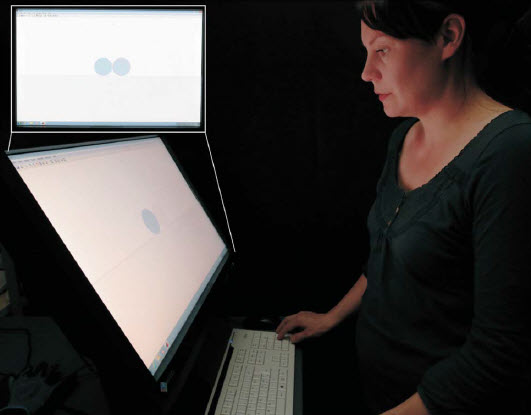How to visually determine thickness at one-nanometer resolution by eye
July 10, 2015

Research shows how accurately a naked human eye can determine the thickness of thin-films from the observed color (credit: Sandy Peterhänsel et al./Optica)
European scientists have taught volunteers in an experiment how to determine the thickness of a titanium dioxide thin film only a few nanometers thick by simply observing the color it presents under under highly controlled, precise lighting conditions, according to Sandy Peterhänsel, University of Stuttgart, Germany and principal author of an open-access paper in the journal Optica.
The optical properties of thin films are the result of light interacting with their surfaces to produce a wide range of colors. This is the same phenomenon that produces scintillating colors in soap bubble and oil films on water.
The specific colors produced by this process depend strongly on the composition of the material, its thickness, and the properties of the incoming light. This high sensitivity to both the material and thickness has sometimes been used by skilled engineers to quickly estimate the thickness of films down to a level of approximately 10–20 nanometers. Could someone see a thinner film?
The experiment

Composed photo of all samples (bottom row) and adjusted color fields (top row). Residual defects of the samples can be seen at the edges of some samples. (credit: Sandy Peterhänsel et al./Optica)
The researchers decided to find out. The experiment setup was simple: a series of thin films of titanium dioxide were manufactured one layer at a time by atomic deposition. While time consuming, this method enabled the researchers to carefully control the thickness of the samples.
The samples were then placed on a LCD monitor that was set to display a pure white color, with the exception of a colored reference area that could be calibrated to match the apparent surface colors of the thin films with various thicknesses.
The color of the reference field was then changed by the test subject until it perfectly matched the reference sample: correctly identifying the color meant they also correctly determined its thickness. This could be done in as little as two minutes, and for some samples and test subjects their estimated thickness differed only by one-to-three nanometers from the actual value measured by conventional means. This level of precision is far beyond normal human vision.
Compared to traditional automated methods of determining the thickness of a thin film, which can take five to ten minutes per sample using some techniques, the human eye performance compared very favorably.
The researchers speculate that it may be possible to detect even finer variations if other control factors are put in place. “People often underestimate human senses and their value in engineering and science. This experiment demonstrates that our natural born vision can achieve exceptional tasks that we normally would only assign to expensive and sophisticated machinery,” concludes Peterhänsel.
Abstract of Human color vision provides nanoscale accuracy in thin-film thickness characterization
We study how accurately a naked human eye can determine the thickness of thin films from the observed color. Our approach is based on a color-matching experiment between thin-film samples and a simulated color field shown on an LCD monitor. We found that the human color observation provides an extremely accurate evaluation of the film thickness, and is comparable to sophisticated instrumental methods. The remaining color differences for the matched color pairs are close to the literature value for the smallest visually perceivable color difference.